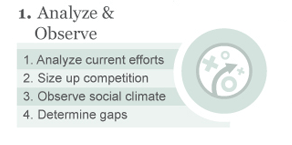What exactly is “digital healthcare marketing?” Does it mean that your dentist is on Facebook by posting before and after snapshots in an online Smile Gallery? Will your orthopedic surgeon share videos of patients that have made a miraculous recovery from a partial knee replacement? Does “online healthcare marketing” describe the newsletter that you received from your primary physician reminding you of your upcoming physical? Or does it mean all of the above? Take a look at the history of healthcare advertising techniques. These have been evolving and reinventing in the 21st century.
The Past — A Brief History of Healthcare Marketing
Around 200 AD, woodblock printing was invented. This heralded an era for physicians, apothecaries, pharmacies, and healers. They could alert the public using “outdoor advertising.” Simply, a rudimentary sign on the side of their wagon. When doctors established an office, they would hang a shingle to let passersby know that they were open for business. Local townsfolk could be healed from whatever ailed them. The most advanced medical services of the day were primitive.
The Introduction of the Typewriter
Johannes Gutenberg invented a movable type machine in 1440. And printing presses throughout Europe increased in sophistication with illustrated posters, handbills, and more. By the 1500s and 1600s, printed flyers, news sheets, periodicals, and newspapers took healthcare marketing to the next level. In America, the New-England Courant became one of the first newspapers in the new world. Benjamin Franklin’s younger brother, James, published it in 1721.
The Importance of Automobiles in Healthcare Advertising
For the next 200 years, the use of the advertising media continued to expand and evolve. When automobiles became popular in the early 20th century, it launched the creation of outdoor board companies. First with signs on buildings in town and on barns in rural communities. And later, 30-sheet outdoor boards along America’s highways. Do you remember the “Burma Shave” ads? Those ads were outdoor advertising at its best – as an early healthcare advertising message for a medicated shaving cream.
The Introduction of Radio Broadcasting
Pittsburgh’s KDKA introduced broadcasting to the world and became the world’s first radio station in the late 1920s. With it, physicians, doctors and a wide range of healthcare products such as Lysol, Listerine, Carter’s Little Liver Pills, hand soap and shampoo finally had the opportunity to reach tens of thousands of listeners simultaneously with a 60-second jingle or live announcer read. Throughout the 20th century, more sophisticated radio ads followed. Enterprising local physicians who wanted to reach the masses through commercial airtime.
Television Changes The Healthcare Advertising Landscape Forever
Next, television set the world on its in the 1950s. Finally, the audience could hear and see the broadcast. Healthcare marketing by physicians and products like pain relievers would never be the same. And let’s not forget the Yellow Pages. Since 1883, the Yellow Pages was a trusted resource by doctors and hospitals to advertise their services. Few people refer to the printed Yellow Pages today. Most doctor listings are available online, as well as everything else.
The Present — Healthcare Marketing Has Evolved to Both Online and Offline Media
During the mid-1990s, the Internet became mainstream and forever changed the landscape of digital healthcare marketing. Hospitals led the way in creating simple websites because they had the resources to invest. Sites used a combination of original content, graphic design, hard-coded webmasters, and original photography. The goal was to let the public know about the healthcare services that their doctors, physicians and pharma companies offered. Over the years, websites have become increasingly more complex and sophisticated, as healthcare advertising has continued to evolve. At first, customers had to search through a website in order to find the phone number. Early websites were often built for aesthetics instead of best practices for direct response techniques. Today, a local private physician practice can compete with well-established hospitals. Their healthcare marketing begins with their websites as a hub for all advertising activities. There are a variety of ways to capture a potential patient’s key information on a website, including:
- Contact forms –– These typically short, simple web forms ask you to complete a few required fields, such as your name, email address and phone number. The shorter the form, the higher the response rate for key patient data.
- Updates with mobile/responsive design –– All websites should now feature responsive design to enable a potential patient with an optimal viewing and interaction experience across a range of mobile devices, from your desktop computer to your tablet to your smartphone. In fact, if your website is not now mobile responsive compliant, Google may not rank your website at all. (More on this later.)
- Clear calls to action –– Most well-designed digital healthcare marketing websites now feature an easy-to-find phone number at the top and the bottom of each page, as well as an easy-to-find address in the footer, and on the Contact Us page. You have to make it easy for potential patients to respond.
- HIPAA-compliant websites –– The Health Insurance Portability and Accountability Act (HIPAA) is a law governing websites. It requires that a website ensures that all protected health information is transport encrypted. In addition, the data is backed up, only accessible by authorized personnel, is not tampered with or altered, utilizes storage encryption, can be permanently disposed of when no longer needed, and is located on secure web servers.
Much more than websites: online and offline media. Websites are just the tip of the iceberg of an overall healthcare advertising online/offline media plan. In addition, organic search, paid search, landing pages, social media, and reputation management to help a private practice compete and win.
- The importance of organic search –– The first and most dominant way for a potential patient to find your practice’s particular services online through healthcare marketing is through organic search. This places specific keywords and keyword phrases on your website with a formulaic density. According to Business Insider report from Custora, organic search totaled 22% of e-commerce orders during Q1 2016, which was higher than any other online medium. While this statistic was for online orders, it’s relevant for organic search for any service. If you’ve hired an expert in SEO keywords and Google Analytics reporting, most savvy physicians can be found online with organic search. Don’t try writing a website yourself. Your website can be ignored by major search engines if you have the wrong keyword density using certain phrases too often.
- The importance of paid search –– Google created the PPC (Pay-Per-Click) ad industry and made billions and billions of dollars, pennies at a time, with paid search. PPC ads appear as the short, three-line ads you see at the top and on the right side of most web search pages with a green “Ad” logo.In the same report mentioned above, paid search ads accounted for 20% of e-commerce orders compared to 17% in Q1 2015. To be successful in reaching more potential patients –– and to better compete with hospitals –– the upper echelon of savvy, successful doctors deploy annual digital healthcare marketing campaigns with budgets for paid search ranging from several thousand to $10,000 or more per month. Paid search is flexible, highly effective and can target men and women of certain age groups. It can be turned on and off at a moment’s notice. As with organic search, PPC is best left to the experts who have proven track records and understand the nuances of PPC ads.
- The importance of landing pages –– When a doctor or medical practice promotes a specific service or product, they may have their marketing agency create a website landing page. This page is where potential patients “land” so visitors can read a recap of the offer they may have seen in an email, an online newsletter, a print ad, radio or TV commercial. A landing page has minimal copy and focused on a single offer for easy visitor response. Your website healthcare marketing visitor can respond without other distractions such as links to other pages. Finally, your patient can fill in a few fields on the landing page with personal data then click “submit”.
- The importance of social media –– Facebook, Twitter, Pinterest, Instagram, Yelp, YouTube, Google+, LinkedIn, and many other social media platforms continue to grow in popularity and fan bases.In terms of popularity, Statista reports that as of April 2016:
- Facebook had over 1.5 billion users worldwide.
- WhatsApp had over 1 billion users.
- Facebook Messenger had 900 million users.
- WeChat had 697 million users.
- Tumblr had 555 million users.
- Instagram recently topped 500 million monthly active users.
- Twitter had 320 million users.
- Pinterest and LinkedIn each have 100 million users. Your healthcare advertising budget can be stretched thin quickly. Prospects use smartphones for faster web searches and there are many choices for social media. It may be difficult to decide which social media platforms are the best fit for your business. Most physicians or big pharma companies keep it simple with Facebook, Twitter, and YouTube for postings.
- The importance of reputation management –– No one likes a negative review for fear of driving away potential patients. The reviews on Yelp can’t be deleted by the company. Facebook or Twitter enable a negative post, comment or tweet to be changed. So choose your social media carefully when considering a digital platform.
The Future of Digital Healthcare Marketing
What’s next in digital advertising? The one thing we can always be sure of is change. You could count on your ads working in newspapers, magazine, radio or television, and direct mail in the late 20th century. Today, it’s another story completely as we have to adjust to a number of new technologies. For the future of healthcare advertising, here are a few recent additions to the mix of products and services to help any doctor, physician or pharma company more precisely target your audience.
- The Use of Beacons –– Beacons are in-store, Bluetooth-enabled devices for retailers. These communicate with a customer’s mobile device. For medical practices, beacons connect with patients in your office within a specific geographic range. They provide enhanced services, real-time questionnaires, follow-up appointment messages, or offer other services.
- Voice Assistant –– We all know about Siri on iPhones, the first successful voice assistant. In May 2016, Google announced Google Assistant (formerly Google Now) to help you perform quicker web searches.
- Ad Blocking –– Ad blocking grew by 48% in the U.S., reaching 45 million active users in 12 months up to June, 2015. This influences your healthcare marketing budget for online paid search ads. Because more potential patients are blocking your attempts to reach them online, you have to consider a media strategy that includes both online and offline media.
- Push Notifications –– These opt-in online messages and emails are growing steadily worldwide for mobile apps to help advertisers boost engagement, retention, and conversion. According to Accengage, opt-in rates during 2014 showed that 46% of iPhone users opt-in to receiving push notifications 46% of the time, while 100% of Android users opt-in when they download an app. The key to optimizing the opt-in rate of your new users is to clear explain the benefits of the information they will receive.
- 360-Degree Photos and Video Tours –– Imagine being able to provide a 360-degree tour of your office with photos and videos to any prospective patient. Facebook introduced this feature in June 2016 for users of iPhones and Samsung Galaxy smartphones. Offices can produce 360-degree photos or videos using apps like Street View or Google Camera, then share it to Facebook.
- Marketing Automation –– This type of service healthcare advertisers enables healthcare marketers to target a certain segment of your audience to receive an important message. For example, you can send an email or postcard to men 50 and older who are patients of your practice. Each is a colonoscopy prospect.
- Virtual Reality –– Similar to 360-degree videos, customers can use this technology to show potential patients your office lobby, newest procedures, laboratories, and your staff. This is especially helpful to any private practice competing with a hospital to show that you have the latest equipment.
- Local SEO –– In many ways, local SEO has replaced the Yellow Pages. This search-based way of finding local businesses is especially important to doctors and physicians. You could be found online with Local SEO by first including your name, address, and phone number information in your website. Next, you linked it to your local web-based accounts like Google+, Bing Local, and Yahoo Local. Local SEO is less costly and more widely used by tech-savvy prospective patients.
- Live Stream Videos –– Two-way telemedicine is here and expanding in use. In fact, according to the 2014 HIMSS Analytics Telemedicine Study, 57% of healthcare organizations now offer two-way video and webcams. Though there are challenges with live stream and telemedicine, live streaming is a viable way to treat patients that live too far from your office.







